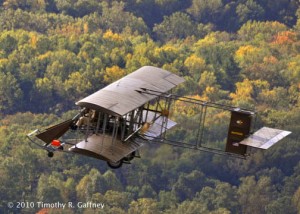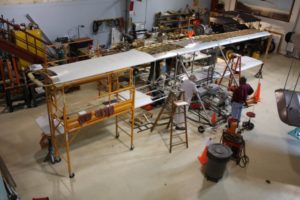-
Making the Brazilian ATR-72 Spin
by
No Comments

Note: This story was corrected on August 10th at 10:23 am, thanks to the help of a sharp-eyed reader.
Making an ATR-72 Spin
I wasn’t in Brazil on Friday afternoon, but I saw the post on Twitter or X (or whatever you call it) showing a Brazil ATR-72, Voepass Airlines flight 2283, rotating in a spin as it plunged to the ground near Sao Paulo from its 17,000-foot cruising altitude. All 61 people aboard perished in the ensuing crash and fire. A timeline from FlightRadar 24 indicates that the fall only lasted about a minute, so the aircraft was clearly out of control. Industry research shows Loss of Control in Flight (LOCI) continues to be responsible for more fatalities worldwide than any other kind of aircraft accident.
The big question is why the crew lost control of this airplane. The ADS-B data from FlightRadar 24 does offer a couple of possible clues. The ATR’s speed declined during the descent rather than increased, which means the aircraft’s wing was probably stalled. The ATR’s airfoil had exceeded its critical angle of attack and lacked sufficient lift to remain airborne. Add to this the rotation observed, and the only answer is a spin.

Can a Large Airplane Spin?
The simple answer is yes. If you induce rotation to almost any aircraft while the wing is stalled, it can spin, even an aircraft as large as the ATR-72. By the way, the largest of the ATR models, the 600, weighs nearly 51,000 pounds.
Of course, investigators will ask why the ATR’s wing was stalled. It could have been related to a failed engine or ice on the wings or tailplane. (more…)
-
How the FAA Let Remote Tower Technology Slip Right Through Its Fingers
by
No Comments
In June 2023, the FAA published a 167-page document outlining the agency’s desire to replace dozens of 40-year-old airport control towers with new environmentally friendly brick-and-mortar structures. These towers are, of course, where hundreds of air traffic controllers ply their trade … ensuring the aircraft within their local airspace are safely separated from each other during landing and takeoff.
The FAA’s report was part of President Biden’s Infrastructure Investment and Jobs Act enacted on November 15, 2021. That bill set aside a whopping $25 billion spread across five years to cover the cost of replacing those aging towers. The agency said it considered a number of alternatives about how to spend that $5 billion each year, rather than on brick and mortar buildings.
One alternative addressed only briefly before rejecting it was a relatively new concept called a Remote Tower, originally created by Saab in Europe in partnership with the Virginia-based VSATSLab Inc. The European technology giant has been successfully running Remote Towers in place of the traditional buildings in Europe for almost 10 years. One of Saab’s more well-known Remote Tower sites is at London City Airport. London also plans to create a virtual backup ATC facility at London Heathrow, the busiest airport in Europe.
A remote tower and its associated technology replace the traditional 60-70 foot glass domed control tower building you might see at your local airport, but it doesn’t eliminate any human air traffic controllers or their roles in keeping aircraft separated.

Max Trescott photo Inside a Remote Tower Operation
In place of a normal control tower building, the airport erects a small steel tower or even an 8-inch diameter pole perhaps 20-40 feet high, similar to a radio or cell phone tower. Dozens of high-definition cameras are attached to the new Remote Tower’s structure, each aimed at an arrival or departure path, as well as various ramps around the airport.
Using HD cameras, controllers can zoom in on any given point within the camera’s range, say an aircraft on final approach. The only way to accomplish that in a control tower today is if the controller picks up a pair of binoculars. The HD cameras also offer infrared capabilities to allow for better-than-human visuals, especially during bad weather or at night.
The next step in constructing a remote tower is locating the control room where the video feeds will terminate. Instead of the round glass room perched atop a standard control tower, imagine a semi-circular room located at ground level. Inside that room, the walls are lined with 14, 55-inch high-definition video screens hung next to each other with the wider portion of the screen running top to bottom.
After connecting the video feeds, the compression technology manages to consolidate 360 degrees of viewing area into a 220-degree spread across the video screens. That creates essentially the same view of the entire airport that a controller would normally see out the windows of the tower cab without the need to move their head more than 220 degrees. Another Remote Tower benefit is that each aircraft within visual range can be tagged with that aircraft’s tail number, just as it might if the controller were looking at a radar screen. (more…)
-
Fathers, Sons and Airplanes
by
No Comments

/
RSS FeedFathers, Sons and Airplanes, by Micah Engber
The New Year comes twice a year for me. Of course there’s this time of year, the first day of January for the year we all know. But there’s also first day of Tishrei, the Jewish New Year called Rosh Hashanah. While there’s a joy to the Jewish New Year it’s more of a time of self-examination and repentance, a ten day process that ends with the holiday of Yom Kippur.
So I started to write this just as Yom Kippur, the Jewish Day of Atonement, had ended, it’d been a week of reflection since Rosh Hashanah. And while this little piece was started at the beginning of the Jewish New Year, it’s just as applicable for the secular New Year.
When I started writing this it had just turned 5779 according to the Hebrew calendar. I just couldn’t get used to it, and I’d been writing 5778 on all my checks, but eventually I got over it. The thing that I didn’t, and I won’t get over though, probably for the rest of my life, is that I miss my Dad.
 Lew Engber, NCO in the Army Corp of Engineers during World War II, First Lieutenant in the Medical Corp of the US Air Force during the Korean Conflict, brilliant psychologist, terrific raconteur, bibliophile, pulp fiction, western and science fiction fan, trivia expert, a gourmet and at times gourmand, airplane geek, beer connoisseur, but most important to me right now, my father. He’s the man who taught me not so much all I know, but kind of, how to know it. He shaped my tastes, my likes and loves, probably unwittingly and unintentionally, but nonetheless, most certainly. Perhaps more importantly he taught me how to learn for myself, how to love and appreciate learning itself, and love to pass on my knowledge to others.
Lew Engber, NCO in the Army Corp of Engineers during World War II, First Lieutenant in the Medical Corp of the US Air Force during the Korean Conflict, brilliant psychologist, terrific raconteur, bibliophile, pulp fiction, western and science fiction fan, trivia expert, a gourmet and at times gourmand, airplane geek, beer connoisseur, but most important to me right now, my father. He’s the man who taught me not so much all I know, but kind of, how to know it. He shaped my tastes, my likes and loves, probably unwittingly and unintentionally, but nonetheless, most certainly. Perhaps more importantly he taught me how to learn for myself, how to love and appreciate learning itself, and love to pass on my knowledge to others.It’s wasn’t just the High Holy Days that had me missing my Dad, although that may have been the impetus. There’s another thing that had me thinking of him. You see it was also the time of year when The Collings Foundation makes an almost annual trip to the Jetport here in Portland, Maine, PWM. This year it was the Wings of Freedom Tour including the B‑24J Liberator, Witchcraft, the B-25 Mitchell, Tondelayo and the TF-51D Mustang, Toulouse Nuts. The B‑17G Flying Fortress, Nine of Nine was stuck in Vermont having just “gone tech”. Yea, I missed the B-17, but I was missing my Dad even more.
You see I grew up with these aircraft, well not these exact airplanes, but these types, or similar. It was talking about aircraft, ships, science fiction and other common interests that I shared with my Dad that helped make us close. You often hear about baseball bringing fathers and sons together, well for me and my Dad, it wasn’t baseball, it was aircraft and flying, among quite a few other things.
-
A Logophile’s Look at Aviation
by
No Comments
 Like many word merchants, I’m a logophile, a lover of words. When a new one catches my attention, meaning I can foresee some sentence in which it might be of use, I record it. For the past 15 years or so, my logo reliquary (“a container in which relics are kept and displayed for veneration,” also, a synonym for an aviation museum) is a reporter’s notebook I got at a Garmin media presentation at EAA AirVenture Oshkosh.
Like many word merchants, I’m a logophile, a lover of words. When a new one catches my attention, meaning I can foresee some sentence in which it might be of use, I record it. For the past 15 years or so, my logo reliquary (“a container in which relics are kept and displayed for veneration,” also, a synonym for an aviation museum) is a reporter’s notebook I got at a Garmin media presentation at EAA AirVenture Oshkosh.Despite decades of collecting, I don’t often have the opportunity to employ many of my discoveries in my pursuit of word merchanthood. But opportunity is what you make of it, so join me for a stroll through the pages for a logophile’s look at aviation.
Without a doubt, today’s enhanced vision systems are perspicacious, which originally meant “having keen vision.” That foundation led to the leading sense of the word’s meaning, “having keen judgment or understanding; acutely perceptive,” which still applies to seeing-eye avionics.
 How to make a million dollars in aviation is a staple of aeronautical humor. Related to it is the t-shirt that proclaims, “Will Fly for Food.” If you want to confound your peers during your next hangar jeremiad (“a long lamentation or complaint”) describe yourself as an impecunious (“having no money; poor; penniless) aviator.
How to make a million dollars in aviation is a staple of aeronautical humor. Related to it is the t-shirt that proclaims, “Will Fly for Food.” If you want to confound your peers during your next hangar jeremiad (“a long lamentation or complaint”) describe yourself as an impecunious (“having no money; poor; penniless) aviator.Jeremiad can also be “a long, scolding speech or sermon expressing disapproval or warning of disaster.” Who hasn’t nodded in agreement with such a sermon on the consequences of an improperly cleaned windscreen, where the residual bugs might be traffic on a collision course? But who have we every heard complimenting the line crew for a pellucid (“transparent, clear”) canopy or windshield?
Investing in an aviator’s raiment contributes to their being impecunious. Some articles, such as a surplus flight suit, will not break the bank, but adding a sheepskin flight jacket, a watch with multiple dials, and shiny sunglasses that reflect airborne aspirations, are another story.
These reflective lenses can be helpful when an aircraft activates its fulgent lighting system. When these “very bright, radiant” lights begin to flash like lightening, it is clear that fulguration is one of their options.
 I could go on, but you’ve likely had enough. But let me leave you with one more as we at JetWhine wish you and yours a happy and prosperous New Year. The hardest question any aviator will ever face is “Why do you fly?”
I could go on, but you’ve likely had enough. But let me leave you with one more as we at JetWhine wish you and yours a happy and prosperous New Year. The hardest question any aviator will ever face is “Why do you fly?”The answer is simple. Flight is many things to many people, but to all it is ineffable: “too overwhelming to be expressed or described in words” and an insatiable pursuit that many hold as “too awesome or sacred” to be spoken of. — Scott Spangler, Editor
-
A New Wright B Flyer for Kitty Hawk Day
by
No Comments
 Happy Kitty Hawk Day! And can you think of a better way of celebrating the 115th birthday of powered flight than supporting the good people who are trying to build (with modern materials and components) a Wright B Flyer at its hangar and museum at the Dayton-Wright Brothers Airport near Dayton, Ohio.
Happy Kitty Hawk Day! And can you think of a better way of celebrating the 115th birthday of powered flight than supporting the good people who are trying to build (with modern materials and components) a Wright B Flyer at its hangar and museum at the Dayton-Wright Brothers Airport near Dayton, Ohio.Those people united in Dayton as the all-volunteer, nonprofit Wright B Flyer Inc. when they built the first flyable lookalike Model B Flyer in 1975. Absent any drawings, they copied the Model B in the National Museum of the United States Air Force, employing modern engineering, components, and materials to meet the current airworthiness standards and requirements. Unlike the original Model B, the lookalike, known as Brown Bird, has a robust steel skeleton, a control wheel instead of levers, ailerons instead of wing warping, and a modern aircraft powerplant.
 There are many ways to support this effort. You can volunteer your time and efforts and expertise. You can make a financial or in-kind (tax deductible) donation. You can undertake a fundraising effort. And you can become a member of the organization. Members at the Aviator level donate $25 a year; Honorary Aviator’s donate $100 (which qualifies them for an orientation flight in Brown Bird); and Life members donate $200, which include the orientation flight and lifetime Aviator benefits, membership card, a quarterly newsletter, and attendance at the annual membership dinner.
There are many ways to support this effort. You can volunteer your time and efforts and expertise. You can make a financial or in-kind (tax deductible) donation. You can undertake a fundraising effort. And you can become a member of the organization. Members at the Aviator level donate $25 a year; Honorary Aviator’s donate $100 (which qualifies them for an orientation flight in Brown Bird); and Life members donate $200, which include the orientation flight and lifetime Aviator benefits, membership card, a quarterly newsletter, and attendance at the annual membership dinner.Construction of the new Model B Flyer is almost complete, and the group was hoping to make its ground tests by the end of this year, if Mother Nature cooperates. If all goes well, the first flight will take place in the spring, maybe May, and after the subsequent flight testing, it should make its first public appearance at the Vectren Dayton Airshow in June 2019.
 Like Brown Bird, the new Model B Flyer will exist to to raise and sustain public awareness of powered-flight’s roots planted by the brothers Wright in Dayton. This is an international effort, and to make overseas demonstrations more practical, the new lookalike Flyer B will be easier to ship to distant locations and operate with a small support crew.
Like Brown Bird, the new Model B Flyer will exist to to raise and sustain public awareness of powered-flight’s roots planted by the brothers Wright in Dayton. This is an international effort, and to make overseas demonstrations more practical, the new lookalike Flyer B will be easier to ship to distant locations and operate with a small support crew.The lookalike Flyer Bs are inspiring and important on several levels. Because they look little like what most people see in their mind’s eye when they think “airplane,” the Flyers encourage the curious to take a second look and, perhaps, ask a question or two. And for those of us already infected with powered flight, the Flyers are a reminder of human ingenuity and motivation to apply it as we pursue solutions to our present and future challenges. — Scott Spangler, Editor



